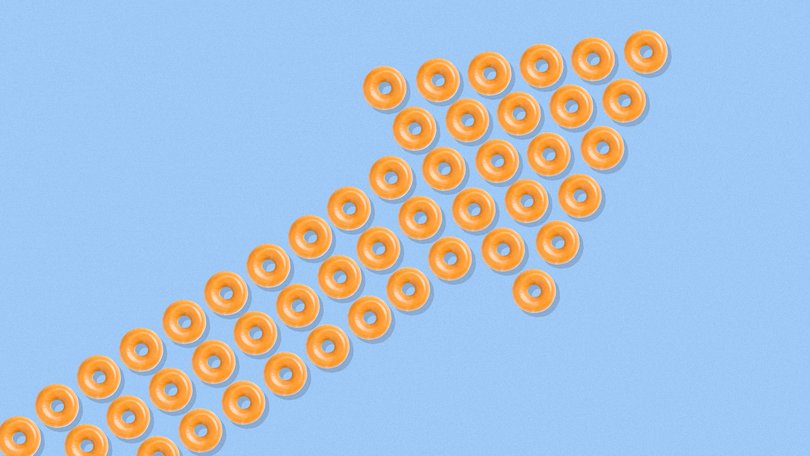BEN HARVEY: Beware of meme stock, don’t let a glazed Krispy Kreme donut trick you into a company ploy

ASX 200 posts biggest fall on record, Reserve Bank flags further measures amid coronavirus fears.
That was the headline on a news story posted in early 2020, a few minutes after the Australian stockmarket dropped 9.7 per cent.
It finished that day at 5120 points.
Sign up to The Nightly's newsletters.
Get the first look at the digital newspaper, curated daily stories and breaking headlines delivered to your inbox.
By continuing you agree to our Terms and Privacy Policy.A week later it bottomed out at 4359 points, having shed a third of its value in barely a month.
If I had told you at that dark low point on March 23, 2020, that in less than six years the Australian Securities Exchange would top 9000 points you would have demanded my resignation on account of my writings being so detached from reality.
Yet here we are. On Thursday the ASX-200 finished trade at 9019.1 points. It closed just under 9000 on Friday.
The question many of us are asking is “when will the music stop?”
The only honest answer to that query is “who knows”.
When people are using their funny bones for stock analysis, then something’s about to give
There’s no doubt the markets are overheated. Just about every price-earnings ratio tells you that.
We are now in a trading environment where so-called meme stocks are considered an actual financial instrument.
If you haven’t heard of this asset class, then good for you. If you don’t know about them, you can’t buy them.
Meme stocks are publicly traded companies whose share prices move up and down not because of their financial performance but due to the popularity of a video or picture on the internet.
Krispy Kreme Incorporated became a meme stock a few weeks ago when Reddit message boards lit up with witty insights into the donut trade.
Because of that sudden pop culture interest, people started buying shares in the company.
Lots of people. Enough people to send the share price up 39 per cent in a few hours.
It wasn’t just the purveyor of the original glazed goodness that was up last month courtesy of nifty memes that caught the ever-fleeting attention of doom-scrollers.
Online real estate agency Opendoor — which gives low-ball cash offers to Americans who are selling their homes and then flips the houses for a profit — was up 43 per cent in one day.
GoPro, the manufacturer of wearable cameras which often capture an adrenaline junkie’s last moments alive, spiked 73 per cent.
Let me stress that there was no good reason for any of those share prices to have moved either up or down.
There were no trading updates, no revised profit guidance and no economic statistics out that supported their business cases.
They went nuts because people with too much money (or access to credit) were bored and stupid.
Meme equities are an important phenomenon to understand because history shows that when people start betting on stocks for completely irrational reasons, the share market music could be about to go quiet.
And when it does, as always, there won’t be enough chairs for everyone.
Exalted former US Federal Reserve boss Alan Greenspan dubbed this type of pre-crash trading mania “irrational exuberance”.
Greenspan issued his warning in 1996 after Wall Street had trebled in value since the 1987 History remembers him as a sage predictor of the tech wreck that subsequently ruined portfolios.
History is forgiving because the statistics show Greenspan was actually a Chicken Little who called the top way too early.
If you had taken his advice and cashed out then, you would have missed out on an astonishing 90 per cent rise over the next four years.
Veteran market watcher Marcus Padley nailed it when he observed that you often make the most during the last days of Rome.
“Some of the best periods of a stock market are the last exponential years before a correction,” Padley said a few years ago.
“Years in which all the value-based systematic history-regurgitating strategists start wagging their fingers saying: ‘It’ll all end in tears’.
“There is plenty of headroom above the Chicken Little threshold for the herd to have a good old stampede and who would want to miss that?”
So, fill your investment boots, dear reader, for if this Chicken Little correspondent could read markets so well as to be genuinely certain the sky was falling, he wouldn’t be tapping on a laptop trying to beat a deadline; he’d be on a superyacht surrounded by supermodels.
Regardless of what the wider market is doing, do yourself a favour and think twice about buying a meme stock for they are a nefarious equity class.
It’s not like someone woke up one morning and randomly decided to make a funny internet thing to brighten our days; meme trading is a highly co-ordinated plan to boost a company’s stock price.
It’s not just any stock that’s meme-able (and before we go further I apologise that Margot Robbie was not available to explain this whilst in a bubble bath).
It can’t be some obscure industrial conglomerate that nobody’s heard of; it must have name recognition.
Also, the company being targeted must be on the nose with the market and the target of short traders.
If you short a stock, you’re betting that the share price will go down.
You borrow a share from someone at, say $1, on the promise you will return it to them, plus a small percentage lending fee, after a set period of time.
You sell the share on the open market for $1 and when it drops to, say 90¢, you buy it back — returning it to the lender and pocketing the 10¢ difference
If you’ve sold the borrowed share for $1 and the price after a few days isn’t 90¢, its $1.10, then you have to make a tough decision.
You promised to return the share, so you’ve got to buy it back on market at some point, so you aren’t empty handed when the contract expires, but if you fork out $1.10 you’re out of pocket by 10¢ — plus the lender’s fee.
You can hope like hell that the stock tanks and puts you in the black but if the arse doesn’t fall out of the market then your predicament gets worse.
If it goes to $1.20, you might cut your losses and buy at that price. Yes, you’ll lose 20¢ but that’s better than buying at $1.50 and losing 50¢.
If short sellers realise en masse that they got it wrong — that the price is going to keep going up, not down — then they’ll all start buying shares to limit their loses.
As they all “close out their positions” the number of buyers outnumbers sellers and the price of the stock starts going up.
You see where this is going?
As the share value rises more short sellers lose the courage of their convictions and, in ever greater numbers, bite the bullet. They reluctantly start buying to stop the hemorrhaging.
The phenomenon is called a short squeeze and it’s the ultimate aim of meme traders.
Pick a publicly facing retail stock that is heavily shorted (lots of people out there betting the price will fall), create a gimmicky internet thing that stokes investor interest in a company so the share price starts rising and triggers a short squeeze that sees the stock value rocket.
Most of us aren’t directly affected by meme trading but we should all be aware of it because when people are using their funny bones for stock analysis, then something’s about to give.

